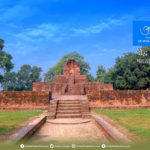
(TAN): Taj, a subsidiary of the Indian Hotels Company Limited (IHCL), is famed for its legacy started by its founder Jamsetji Tata in 1903 with the opening of the Taj Mahal Palace in Maharashtra state’s Mumbai.
The iconic luxury hospitality brand has grown from strength to strength in the ensuing century, with 86 hotels in 54 destinations across the world that feature over 12,130 guestrooms. Along with the expansion of the hotel chain in major Indian metropolitan cities such as Kolkata, Bangalore, Delhi, Hyderabad, and Chennai in the 1980s, Taj reached foreign shores with properties in countries including Maldives, Bhutan, Malaysia, South Africa, Nepal, Sri Lanka, United Arab Emirates, Zambia, the United States, and the United Kingdom.
Also part of one of India’s largest business conglomerates, the Tata Group, the Taj properties are categorised into Taj Hotels, Taj Palaces, Taj Resorts and Taj Safaris, that are designed to offer distinct experiences and appeal to diverse palates.
[ALSO READ: Amsterdam raises tourist tax in a bid to fight overtourism]
Taj Hotels are celebrated worldwide for their opulence that is a marriage between local culture and world-class comforts. What stands out is their ability to dish out delectable culinary experiences, ranging from the regional to the global.
Taj Palaces properties provide a window to India’s royal past – grand Indian palaces, dating back to 1700 AD, are tastefully restored to hotels that enable guests to travel back and forth in time. Present across destinations in India, they include themed suites and serve items made from recipes born during the times of the Maharajahs.
Taj Resorts are designed to bring out the essence of their locations where guests can relish optimum relaxation. While their villas and rooms are renowned for views of the garden, sea or sunset, guests are offered all-round well-being through spa treatments and sustainable food.
[ALSO READ: Scotland’s Year of Coasts and Waters 2020 begins]
Taj’s Luxury Safari Lodges are located in or close to India’s national parks, and operate on a light carbon footprint for sustainability’s sake. They provide guests the thrill of the wild, with guides taking them on animal-spotting, hiking and other adventures.
The IHCL brand lets its guests enjoy exclusive benefits through its loyalty programme – Taj Inner Circle, which comes in four tiers; namely Platinum, Gold, Silver and Copper. Using them, guests can upgrade room categories, use in-room check-in or attend specially curated events. Taj Advantage Plus, on the other hand, helps guests earn points while booking that can be redeemed later for holiday or dining vouchers.
India’s first exclusive business club, The Chambers, was established at the Taj Mahal Palace, Mumbai in 1975 to assemble global achievers under the same roof.
[ALSO READ: Turkey hosts nearly 43 million foreign tourists in first 11 months of 2019]
Mumbai’s Taj Mahal Palace, that had already been hosting famous international personalities for decades, achieved global fame overnight when it came under terrorist attacks in November 2008. Guests, including international ones, and staff were shot and killed indiscriminately by terrorists, while videos of parts of the hotel burning went viral.
The attacks were made at a time when India’s economy was already slowing as an effect of the global recession. India’s hospitality industry, that too was dipping, was further hit by the assault. Growth in average room rates had slackened to 11% in the seven months ended October 31 from 16% a year earlier, a Mint report said.
Around a dozen countries reportedly advised their citizens against travelling to India. International tourist arrivals, especially from Europe and the United States, had reportedly dropped 40% to 60% following the attacks.
[ALSO READ: Croatia posts 9% increase in tourism revenue in first nine months of 2019]
“The entire tourist season of 2008-09 is totally ruined. We’re expecting a 25% fall in the number of tourists. Large-scale layoffs loom on the horizon,” Secretary-general, Federation of Hotels and Restaurants Association of India, Harish Sud, was quoted by TIME as saying.
Although the structure took a massive blow, the hotel reopened after 21 months of renovation that reportedly cost USD 38 million.
“This flagship property, this venerable Old Lady, is going to reopen in the same glory, the same splendour of more than 100 years,” Ratan Tata, chairman of the hotel group, was quoted by Fast Company as saying at the time.




